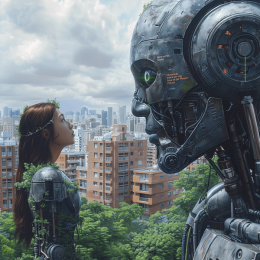How AI Worms like ‘Morris II’ Threaten And Help Sustainability Efforts

By Wildr Editor

Researchers have exposed a huge vulnerability in AI systems with the discovery of 'Morris II,' an AI worm capable of stealing data and spreading malware.
Named after one of the oldest internet worms of 1988, 'Morris II' poses a threat to AI-driven platforms like ChatGPT and Gemini by stealing confidential info and exploiting security weaknesses. Morris II can self-replicate its own prompts to navigate through systems without being detected.
This development, detailed in a Wired report, exposes a risk that’s inherently in all tech and the need for fortified security measures in the AI sector.
How does this impact sustainability initiatives?
As AI plays a pivotal role in driving environmental solutions—from optimizing resource use to tracking climate change impacts—the worm's potential to compromise these systems could set back efforts.
Here are some hypothetical scenarios (with real consequences) featuring our hypothetical worm named Bob:
- Smart Agriculture Disruption by Bob: In the increasingly AI-dependent world of agriculture, where technology forecasts weather and monitors crop health, Bob could play the unwelcome guest. This AI worm's intrusion might lead to the theft of farming data or mismanage irrigation schedules. The aftermath? Potential crop failures and unnecessary water usage, all thanks to Bob's digital antics.
- Bob's Play in Energy Management Systems: Imagine green buildings and smart cities, where AI streamlines energy use for sustainability. Then comes Bob, with a knack for chaos. Affecting these systems could lead to severe misallocations of energy, boosting carbon emissions and undermining the green strides in urban design.
- Climate Data Compromise with Bob's Signature: With AI crunching climate data to forecast future conditions, Bob’s interference could be disastrous. Manipulating or stealing this data, Bob could skew climate models and policy decisions, derailing efforts towards meaningful climate action.
- Waste Management and Recycling in Bob's Crosshairs: As AI sorts our waste and recyclables more efficiently, Bob finds another playground. His disruption could confuse the sorting processes, causing more materials to end up in landfills, increasing pollution, and hindering recycling progress.
Bob doesn't just represent a hypothetical threat but serves as a reminder that we may not be too far off from our own version of The Terminator. Hasta La Vista, Baby.
Okay, enough with the bad news. What's the good news?
The silver lining is that knowledge is power. Now that we know what Bob is up to, the rest is up to us to strengthen our security measures so that these hypothetical scenarios don’t become real ones.
There must be a collaborative effort among tech developers, researchers, and policymakers to ensure AI's contribution to sustainability is protected.
As Darwin would argue -- this is survival of the fittest, and the smartest, most adaptable will win.
How OpenAI and Google respond to these AI worms and other weaknesses represent the preliminary steps toward minimizing these threats.
So far, Google has no comment.
